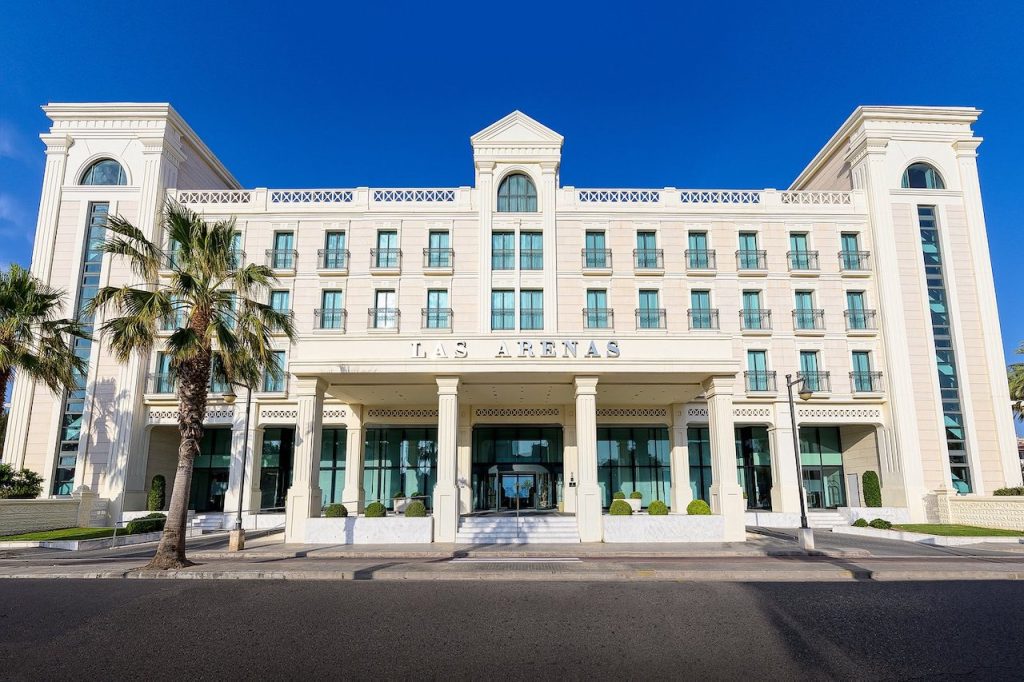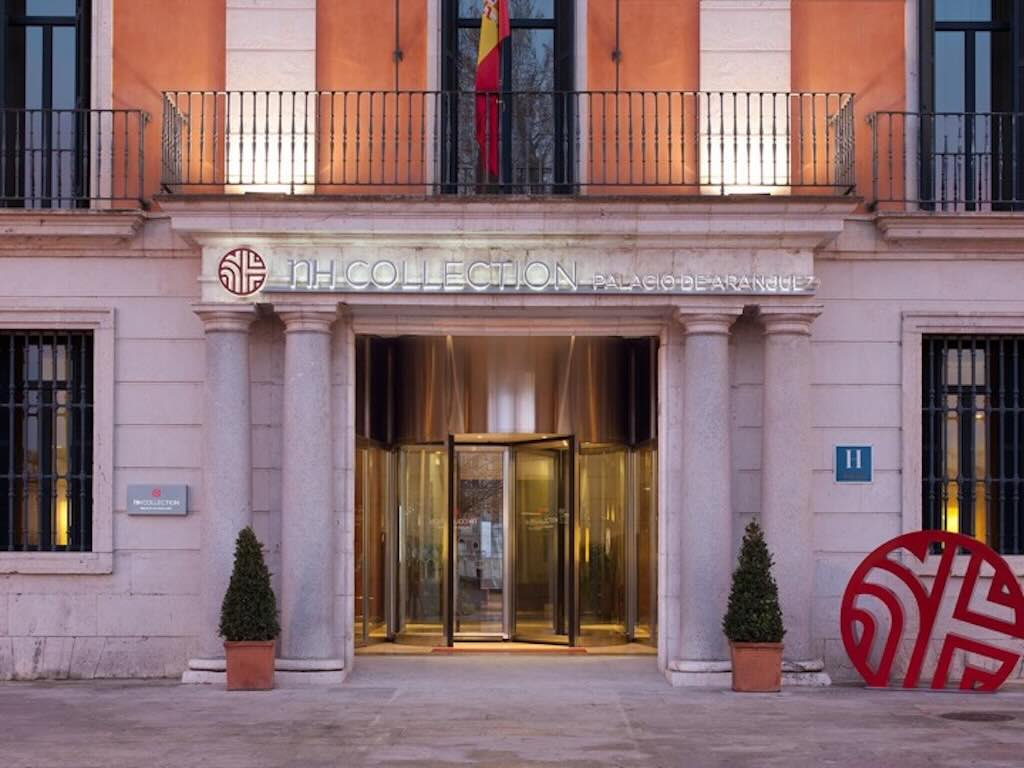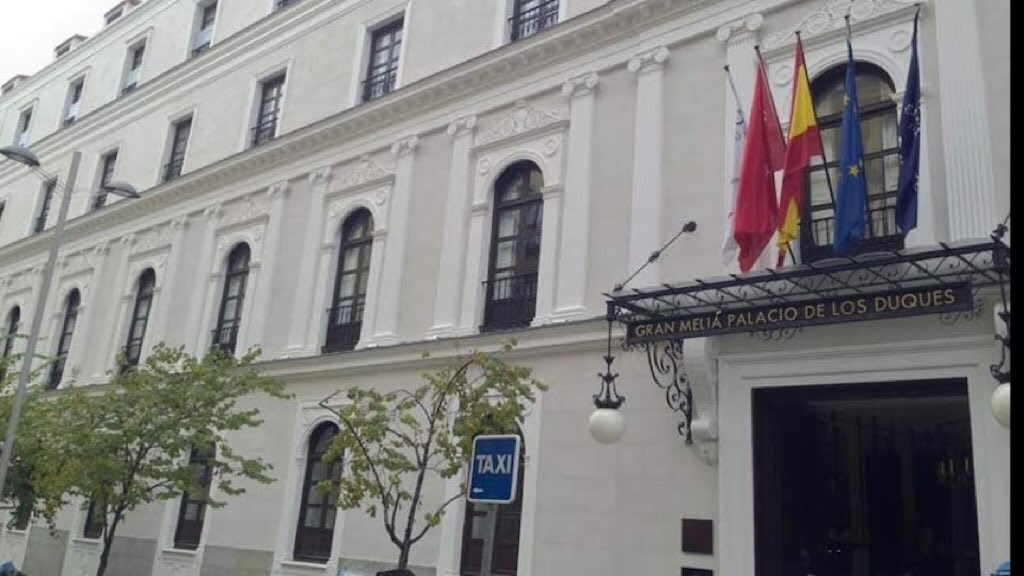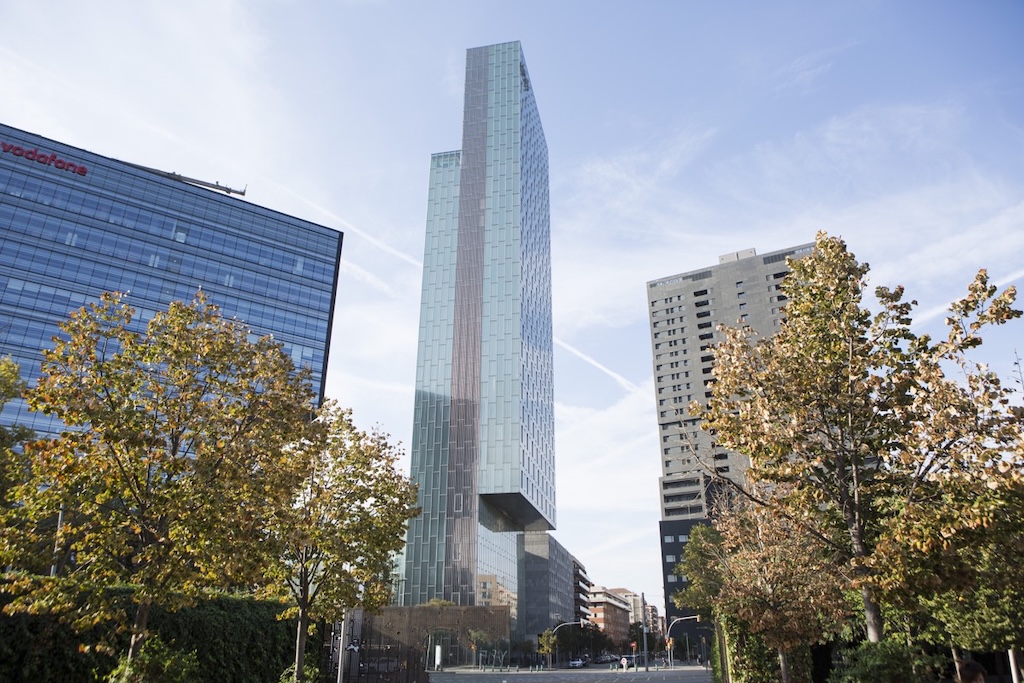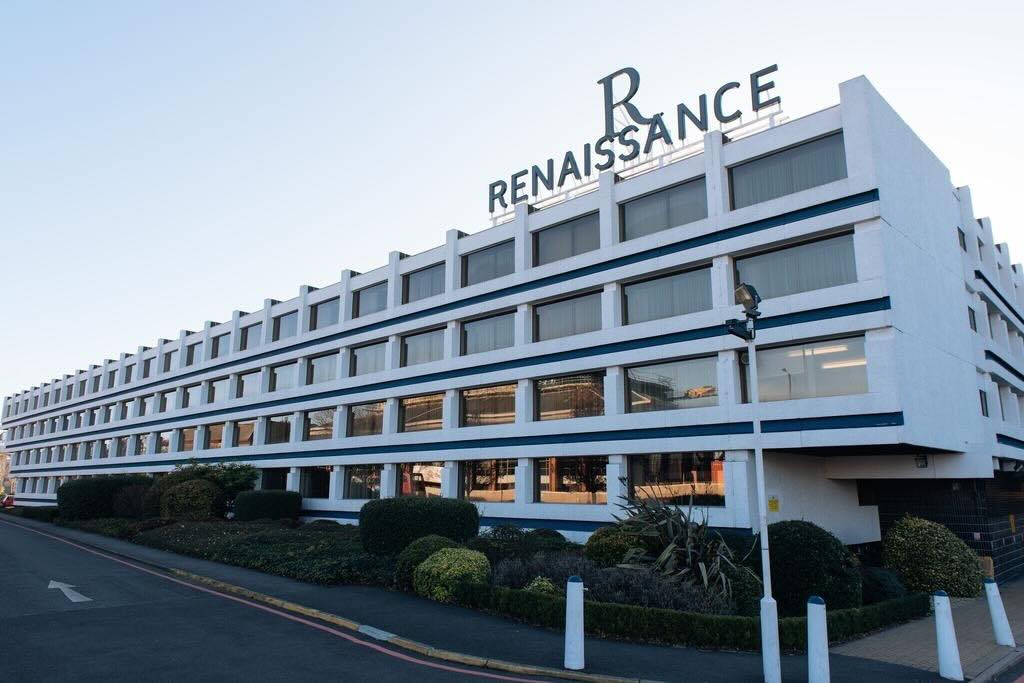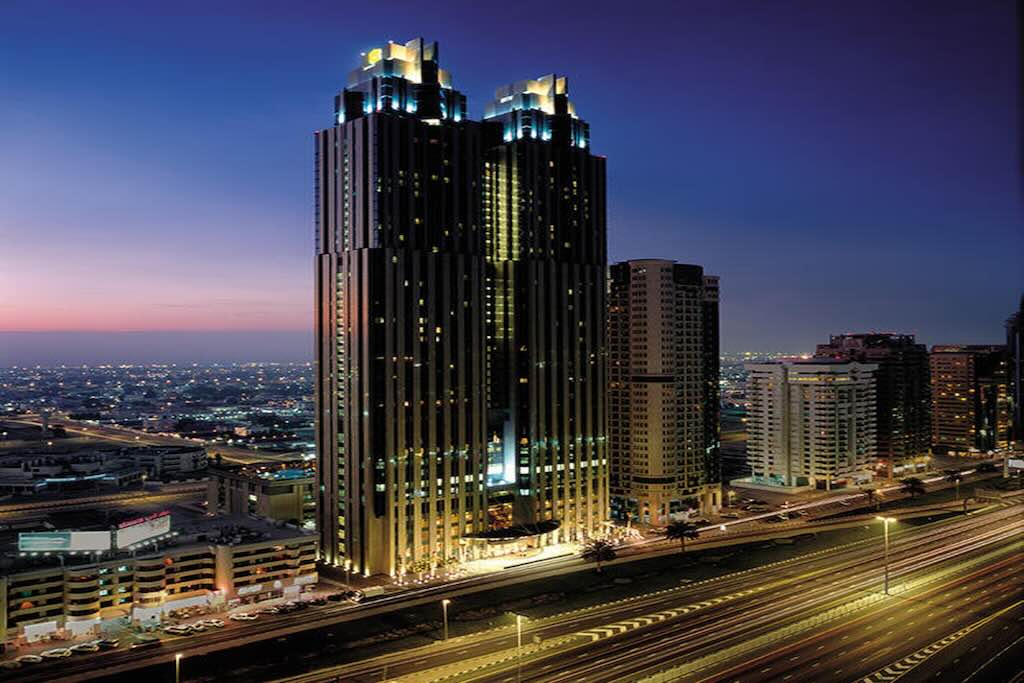I’ve flown in a Boeing 737-800 occasionally in the past, but this review is about a flight from Malaga to my home base in May 2024. At the end of this post I will also rapidly mention my return flight to Malaga using the same company.
For the flight from Malaga the aircraft was LX-LBA and it was scheduled to leave Malaga (AGP) at 15:40, estimated to land in Luxembourg (LUX) at 18:20.
The same aircraft had already flown a return trip to Palermo International (PMO) in the early morning, had accumulated some delays, and landed in Malaga 24 minutes late at 15:14.
I left Malaga at 16:18 (38 minutes late), and landed at 18:48 (28 minutes late). The delay on this flight was on average about 18 minutes.
On July 25, 2021, Luxair introduced SUMO Artwork on some of its aircraft. The livery was designed by the local street artist Christian “SUMO” Pearson. But this particular aircraft celebrating Esch (European Capital of Culture 2022) was designed by Lynn Cosyn who also has the website cosymore.
Ticketing with Luxair
Luxair is Luxembourg‘s only passenger-carrying airline, and they offer both regular, non-charter services, and charter and seasonal services through LuxairTours.
On the Luxair web site they offer 90 different “city-style” destinations, ranging from Djerba (Tunisia) and Rovaniemi (Finland) to Dubai (UAE) and Marsa Alam (Egypt).
Some of these destination are served seasonally and possibly only once or twice weekly, but others such as London City and Malaga are served daily.
Alongside Luxair there is also LuxairTours which offers vacation packages to over 80 destinations. Many of the destinations offered by Luxair overlap with tourists destinations offer by LuxairTours. This means that ticketing is limited to the usual economy options, called “Light”, “Smart” and “Flex”. In some cases a “Business” option is also available, but not for package-holiday destinations such as Malaga.
Luxair can’t be considered a low-cost or budget carrier, but it offers a very convenient option for people living in Luxembourg or in the local region.
I booked my return flight 24 days before travelling, and used “Flex” to ensure the greatest flexibility. I knew there was a small chance that I might cancel the round trip, and there was also a non-negligible chance that I might have to change the return flight date. Given the uncertainties about my schedule, but also the fact that it was tied to a series of appointments, etc. I took out an additional travel insurance for 25€.
I received immediately my electronic ticket, and was informed that I should bring a valid ID card or passport with me on the day of departure. I also booked my seat, a free service for those travelling with “Flex” tickets.
At the same time I also received a separate email informing me about travelling with dogs and cats, and other animals, as well as with sports equipment, additional baggage and heavy baggage.
Two days before departure I received an email about cabin baggage guidelines. It was a generic “warning” message about size and weight limits applied to cabin baggage. I was planning on travelling with only one cabin baggage and a small “personal item’ bag.
Although it was a generic message, I did check that the dimensions of my baggage were within the limits, and I also removed some items to keep below the 8 kg maximum weight for personal items. The reality was that no-one checked, and I saw a few passengers with cabin baggage that exceeded the limit, although many (like me) had hard-shell roller-style suitcases that were designed as carry-on.
Exactly 24 hours before the envisaged departure time I received an online check-in invitation email. I did the check-in and received a boarding pass, which I printed and downloaded by email and as an SMS.
Four minutes after receiving the online check-in invitation, I received a “Smart Upgrade” offer. It offered me the option to block an empty seat next to mine to “get more personal space in the sky”. This would have cost 60€ extra. I had book an aisle seat, and checking the online seating plan I saw that that my row was full. There were quite a number of “free” seats shown, but I decided that for a short hop of about 150 minutes it was not worth the cost. I’m not sure how it would have worked out because on the day the plane looked full, and I actually didn’t see any free seats.
Five minutes after landing I received another “Smart Upgrade” offer for my return flight, booked in 9 weeks time. Even if I had not yet booked a seat on the return flight.
Malaga Airport
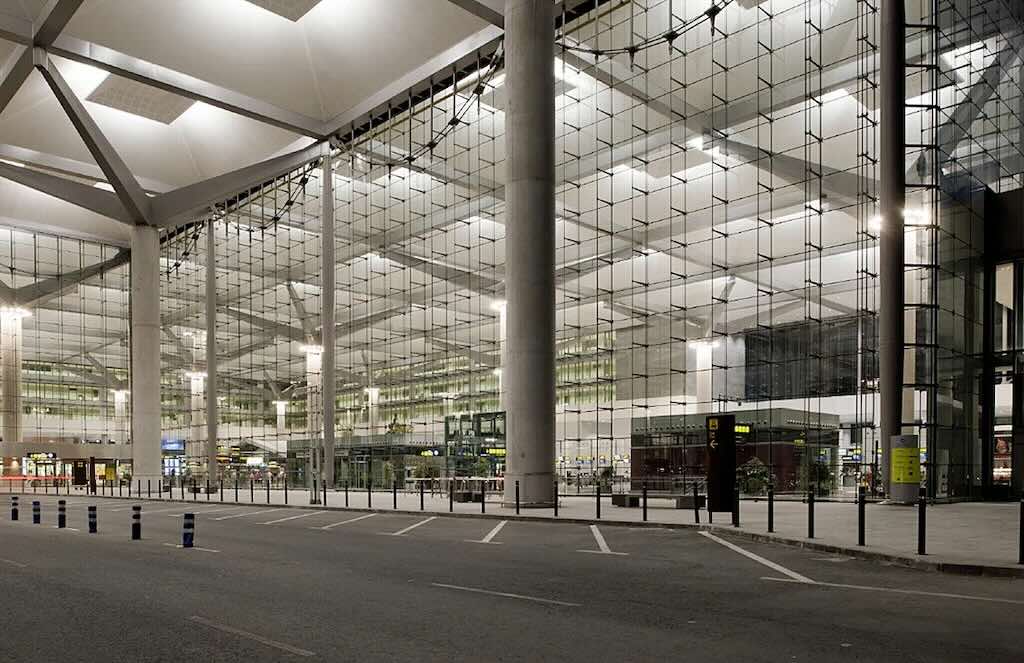
Let’s start with my actual trip.
I had booked a taxi to Malaga airport, that dropped me off at the main departure hall. Unlike in the above photo, the main departure is usually full of taxis dropping off passengers, but it was not overly crowded.
Malaga airport was originally conceived by the Frenchman Pierre Latécoère who was looking to connect France and its African colonies through Spain. It was on March 9, 1919, Latécoère landed in a Salmson 2A over the area called ‘El Rompedizo‘, now an international airport. Remember the maximum range of a Salmson was 500 km.
In September of the same year, the first commercial line between Toulouse and Casablanca was inaugurated, with a stopover in Malaga. After a few years operating as an aerodrome, in 1937 it became an airbase. And in 1946, the airport was definitively opened to national and international air traffic and the first civilian terminal for passengers was inaugurated in 1948. In 1991 the Pablo Ruiz Picasso Terminal (T2) was inaugurated, and in 2011 the new 250,000 square-metre airport terminal (T3) was opened and the airport took the name Airport of Malaga – Costa del Sol.
The international IATA code is AGP, simply because the first letters of the name of the city were already assigned to other airports. So, they used the fourth and fifth letters (AG), and assigned the last letter (P) at random.
In reality Malaga Airport has 5 terminals. T1 and T2 are now only used to take overflow traffic from the new terminal T3. Terminal 4 is the General Aviation Terminal (TAG) and Terminal 5 is for cargo.

Above we can see the main departure hall of T3. In the background are the check-in desks, and in the foreground the boarding card control and security checks.
We can just see the cordoned queuing area to pass through the boarding card control, and the scanners for the security check.
I had already my boarding card. There were no queues, and the automatic boarding card barcode scanner worked perfectly. As suggested by many, I moved left (not right) and more or less went straight through a security scanner for my bags, and then walked through the portal scanner. I had placed my computer and iPad is a separate tray and also had a separate small transparent ziplock bag with the spray for my glasses and some small aftershave samples.
The whole routine took about 5-7 minutes.
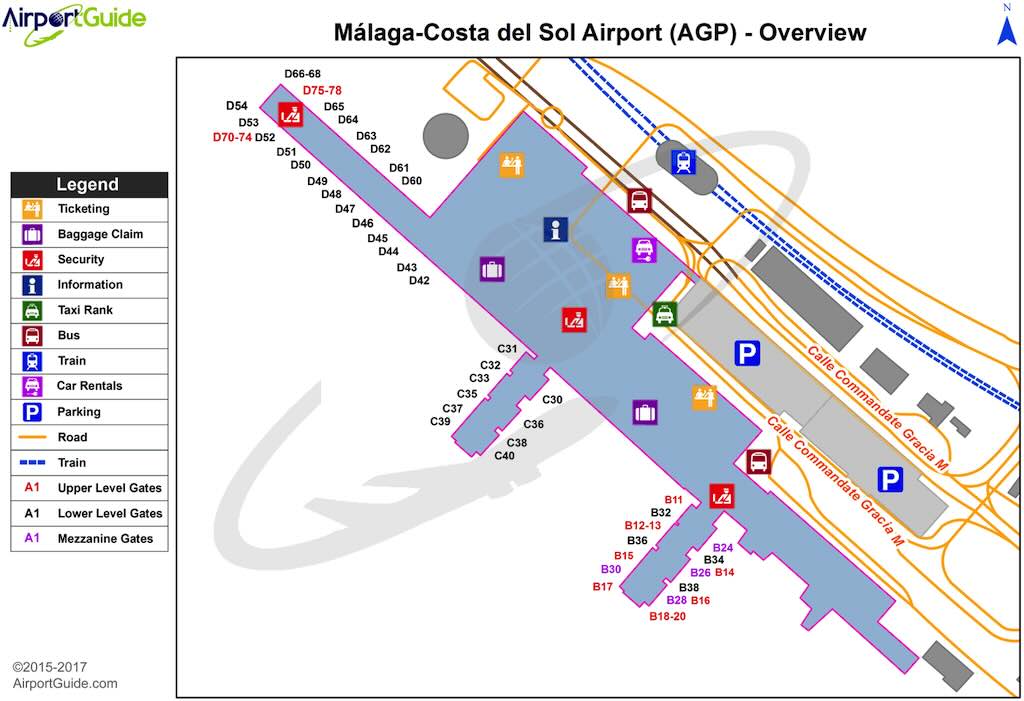
I was in the terminal building with just a little under two hours to departure.
However, immediately a delay was announced, with a new departure time of 16:25 and not 15:40. The gate was not indicated, except that it was in D.
I took a coffee and waited. I suppose the good thing was that the delay was refreshed regularly, to 16:09, 16:13, then 16:04.
My guess is that the gate D54 was announced when the aircraft landed.
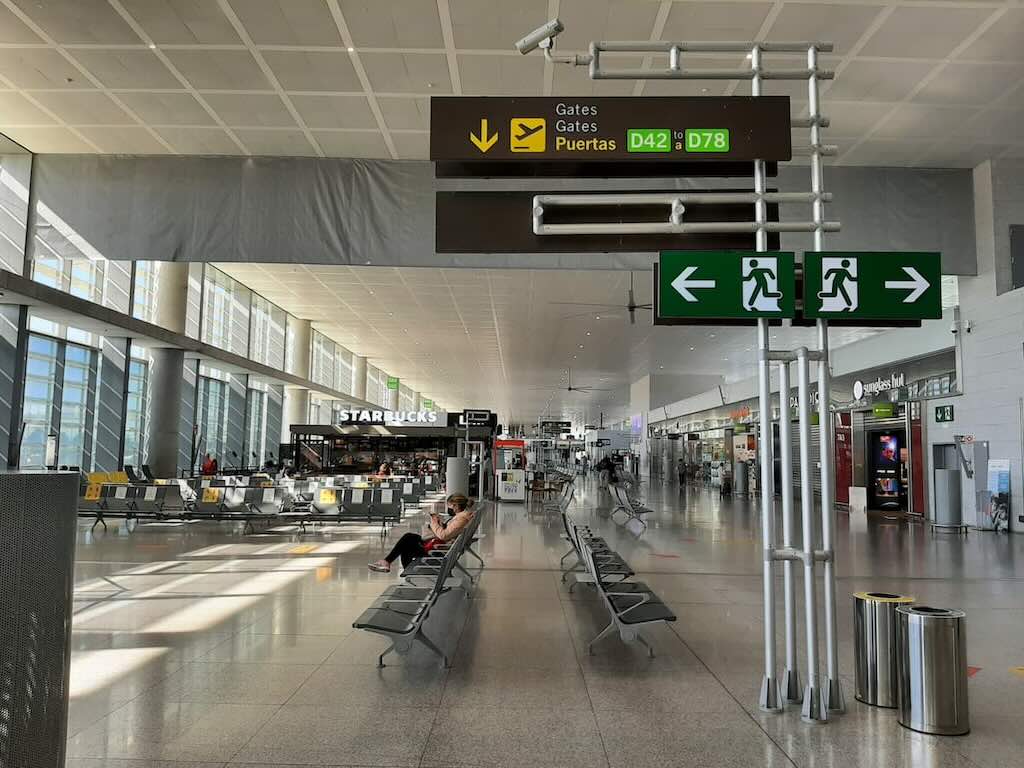
Boarding
I strolled along to find quite a number of people waiting around D53, D54, and D66-68, but it was not overcrowded. The incoming flight was debarking in a very casual way. No big queue waiting to board. They called boarding, so I drifted along, and was in the first 10-15 people boarding, although we had to wait 5-10 minutes on the jet bridge.
Found my seat near the emergency exits over the wings, took out my headphones, and put my bags in the overhead locker. Everything went very soothly, without fuss, all very calm. It was quite surreal compared to some flight I’ve taken.
There was no real welcome on boarding, just a hello (Moien in Lëtzebuergesch), and no one checked board cards.
Getting settled

I guess there was a safety briefing, and the usual messages from the captain. Very unmemorable. Takeoff was fine, and slowly food and drinks arrived. I guess everyone was happy because we had taken off and we had more than two hours before landing. So no hassle, no pressure, and I didn’t notice many people getting up, walking around, going to the toilets, etc.
With the noise-cancelling of my headphones I didn’t hear any messages, etc.
Food & drink

Above we can see the food plateau offered during the flight. In addition I took some sparking water, and later a coffee with milk.
In the little carton box there were cutlery, along with a small piece of cheese, a cube of butter, piece of chocolate, and a small humid serviette.
The main meal was not the most elegant, but was surprisingly tasty (if you had been waiting some hours in an airport). The bread, butter and cheese were fine, and the small piece of chocolate went well with the coffee.
I was not sure what the thing in the upper left was. I decided it was probably a dessert. I guess I was a right, but it was totally inedible. I was deeply disappointed, it doesn’t take a genus to put a small tasty piece of cake or tart in a small square of plastic.
Comfort
I don’t have any real complaints about the comfort. There was space for my bags, enough room for my knees, enough space on the fold-down tray, the headrest was not bad, and there was the usual ‘thing’ to hold my iPhone to the seat back so I could control my headphones.
The only criticism I would have is that the seat was not that comfortable. The seat felt a bit like there was a solid bar across the back of my thighs. Not really a problem for a shortish flight, but not particularly comfortable. I had felt this bar on longer flights, and it can gradually start to feel uncomfortable.
Landing & disembarking
Landing was fine, but I was disappointed that we didn’t get to disembark on a sky-bridge. The main airport building has them, but we had to take a bus. It didn’t affect me personally, but some of the elderly passengers had some problems getting down the steps.
Reviews of Luxair flights
There are only few video reviews of Luxair flights, and surprisingly very few on the Boeing 737-800. One is a video of a Luxair flight to Lanzarote, but there is no commentary and not much on the interior, food, etc.
On the other hand there are lots of video reviews on the 737-800. You can start with a cold-dark start on a 737-800 simulation. And here is a Start and Takeoff Procedure, and an Approach and Landing.
I checked through some of the online reviews for Luxair flights. I know the company, and I’ve flown with them many times over the last 40 years.
I found Flight-Report the most credible with 97 verified passenger reviews, often with photos.
I was surprised to see on Tripadvisor a recent series of very negative (1-star) reviews. Some of the reviews echoed the same messages, and some of them didn’t sound credible or realistic. I’m not starry-eyed about Luxair, but “crappy” planes and very bad service and personnel appeared to be repeated several times, often by people who had made only one or two contributions. In several 1-star reviews it was mentioned that they had been (all) waiting 42-days for some kind of reply.
Skytrax lists reviews as either “trip verified” or not, and it’s true that they have a wide variety of positive and negative reviews, including some 1-star “trip verified”.
I noticed that some 1-star reviewers were truly dedicated to including the same identical-worded negative reviews in Tripadvisor, Skytrax, Trustpilot, and other review sites. It’s a shame because these fake-sounding negative reviews pollute both the positive and negative reviews offered by honest passengers.
I would also point out that there are a few 5-star positive reviews that sound just as odd, since Luxair is not, repeat not, Emirates or Singapore Airlines. As far as I’m concerned it provides a decent service, is conveniently located, is over priced, but is better than the usual low-cost or budget companies.
What do we know about LX-LBA?
The most obvious fact is that it is a Boeing 737-800. It’s what is written on the Flight Safety Instructions, found in the pocket on the back of an aircraft seat. Occasionally it’s written Boeing type B738, but it means the same thing.
As already mentioned the round-trip to Malaga followed an earlier round trip to Palermo. Between the 8 May and the 19 May (11 days), this aircraft made a total of 25 return trips, including to Monastir-Habib (twice), Gran Canaria, Lanzarote (twice), Palma de Mallorca (three times), Menara (Marrakesh), Nice, Rome-Fiumicino (three times), Madeira, Faro, Djerba-Zarzis (twice), Porto, Málaga (twice), Ioannis Kapodistrias (Corfu), Rhodes, Palese Macchie (Bari), Hurghada, and Palermo. As far as I can see all package tour trips.
Understanding more about this particular aircraft, depends upon a series of difficult to decipher codes.
So “737-800” appears to points to one version of the Boeing 737 NG (Next Generation). The original Boeing 737 was conceived in 1964, but in 1984 a new version or “second generation”, the Boeing 737 Classic, was introduced.
The 737 is a so-called narrow-body aircraft or single-aisle aircraft, as opposed to wide-body aircraft or twin-aisle aircraft. And the 737 family are all powered by two underwing turbofans.
The 737 family started with the Original 737-100 and 737-200. The 737 Classic was the series 737-300/400/500. The Boeing 737 NG (Next Generation) was introduced in 1997, and the series includes the 737-600/700/800/900. However, in 2016 a new 737 version, the Boeing 737 MAX, was introduced. The 737 MAX 7, MAX 8, and MAX 9 are intended to replace the 737-700, -800, and -900 respectively, and a further-stretched 737 MAX 10 is possible.
It is the 737 MAX that suffered two fatal crashes, Lion Air Flight 610 in late 2018 and Ethiopian Airlines Flight 302 in early 2019, and was subsequently grounded worldwide from March 2019 to November 2020. The 737 MAX was allowed to return to service in late 2020, but has been hounded with problems since then.
The reality is that a simple identifier such as 737-800 is useless. There are many, many different versions of the same basic airframe. For example, just for airport planning Boeing lists 15 different versions of the 737, and then there different dimensions, different ground clearances, different cabin cross-sections, different interior arrangements, different cargo compartments, different door clearances, different maximum payloads, different ranges, different service requirements and connections, different tyre requirements (including pressure), different conditioned airflow requirements, different towing requirements, different jet engine exhaust conditions (velocity and temperature), different landing gear footprints, different pavement loads, and different runway requirements (dependent upon weather conditions) for take-off and landing.
LX-LBA is a unique airframe identity code. So it’s easy to find out that it was purchase new by Luxair, and made its first commercial flight on 13 February 2015, making it 9.3 years old. Codes such as LX-LBA are unique, but they are not as unique as airframe serial numbers (these number don’t change, whereas the airframe identity code can change if the owner-operator changes).
LX-LBA is not the youngest Boeing in the Luxair fleet. LX-LGV came into service in 2014, but LX-LBB has a somewhat different history. It actually came into service in April 2015 as D-ABMZ for Air Berlin. This carrier ceased operating in 2017, but went through a major restructuring in 2015, and no doubt sold-transferred D-ABMZ to Luxair. The aircraft was then registered as LX-LBB in October 2015.
Very recently Luxair has registered LX-LBK and LX-LBL, both Boeing 737-8MAX. Both are leased from Pembroke. LG-LBL was originally leased by Air Italy as EI-GGL delivered 20 November 2018, and then delivered to Luxair on 2 July 2023. LX-LBK was also leased by Air Italy as EI-GFY delivered 13 May 2018, and then delivered to Luxair on 15 September 2023. In fact, on 11 February 2020, Air Italy ceased all its own operations and went into liquidation.
Pembroke Capital Aircraft Limited, founded in 1997, is registered in Dublin, Ireland. The company’s portfolio comprised of over 100 narrow-body and wide-body Airbus and Boeing aircraft. Until recently Pembroke was a wholly-owned subsidiary of Standard Chartered PLC, however I understand it is now part of the Saudi Arabian lessor AviLease, a transaction valued at $3.6 billion.
One important identifier is the airframe serial number, and for LX-LBA it’s 43537. this means that it is only one of three of the model 737-8C9 (the “8” referencing the 737-800 family). All three were delivered to Luxair.
Another unique way to identify an aircraft is using the ICAO24 code, sometimes called the Mode S code. This is a 24-bit unique number that is assigned to each vehicle or object that can transmit automatically information that allows others to track their position via satellite navigation. The ICAO is the International Civil Aviation Organization, and Mode S is an aviation transponder interrogation mode. Mode S transponders transmit information about the aircraft to air traffic control, to traffic collision avoidance receivers on board aircraft, and to the satellite navigation systems. LX-LBA has the unique hex code 4D00F4.
Another definable feature of an aircraft is the seat plan, and there is a wide variety of options depending on the carrier. For example, LX-LBA is usually tagged as C12Y156 which probably means 12 “comfort” seats and 156 economy seats. It’s possible to reconfigure seating, by changing the seats, by inserting or removing seat dividers, and by changing the pitch, e.g. leg room. For example, LX-LBB had a seating code Y186, or 186 economy seats. These additional seats are created by replacing the 12 “comfort” seats, and changing the seat pitch.
Different ticketing options all conform to a set of fare basis codes, which define which type of seats and services are on offer. These are alphabetic or alpha-numeric code used by airlines to identify a fare type and allow airline staff and travel agents to find the rules applicable to that fare. Many airlines appear to use some more or less standard codes, such as F (first class), B (business class), W (premium economy), and Y (economy). Then there are codes for one-way, return, seasons, child, infant, holiday charter, etc. On top of that different companies will have a whole zoo of codes for different options. Luxair has Z-C-J for business class, and W-R-A-N-G-O-H-F-X-L-S-B-Q-K-M-Y for “Flex”. I don’t know exactly what my code represented, but I do know that it also corresponded to a certain number of ‘miles’ on my Miles & More VISA card.
Return flight to Malaga
With my “Flex” I had pre-booked a return flight for 2-3 months later, knowing that I would later need to change it. Finally I decided to fly back earlier, and there was no problem in re-scheduling my flight. However, the system wouldn’t let me book a new seat. It told me I could not book a seat less than 50 hours before departure (it was 6 days before departure). I phoned Luxair ticketing (wait time about 7 minutes) and they made the seat re-booking.
Two days before departure I received a “must read” email about “Cabin Barrage Guidelines”, and exactly 24 hours before departure I received an email for online check-in. I also received the “usual” offer to buy one or two spare seats next to me, which I declined. In any case the flight was almost full.
My boarding card was issued with “Fast Lane Access“. This provided a reserved lane through passport control, and a direct feed into a line for security control. Friday afternoon was quite crowded, but security only took 5 minutes or so.
My Miles & More gave me some lounge access vouchers, so I used one of them. The lounge was crowded, and the food was not replenished rapidly (only buffet food and nothing hot). The smoked salmon was nice, the cheese was fine, but the cake selection was poor. I took a glass of white wine, and a coffee. You can quickly get bored waiting (in the old days there were newspapers and magazines available).

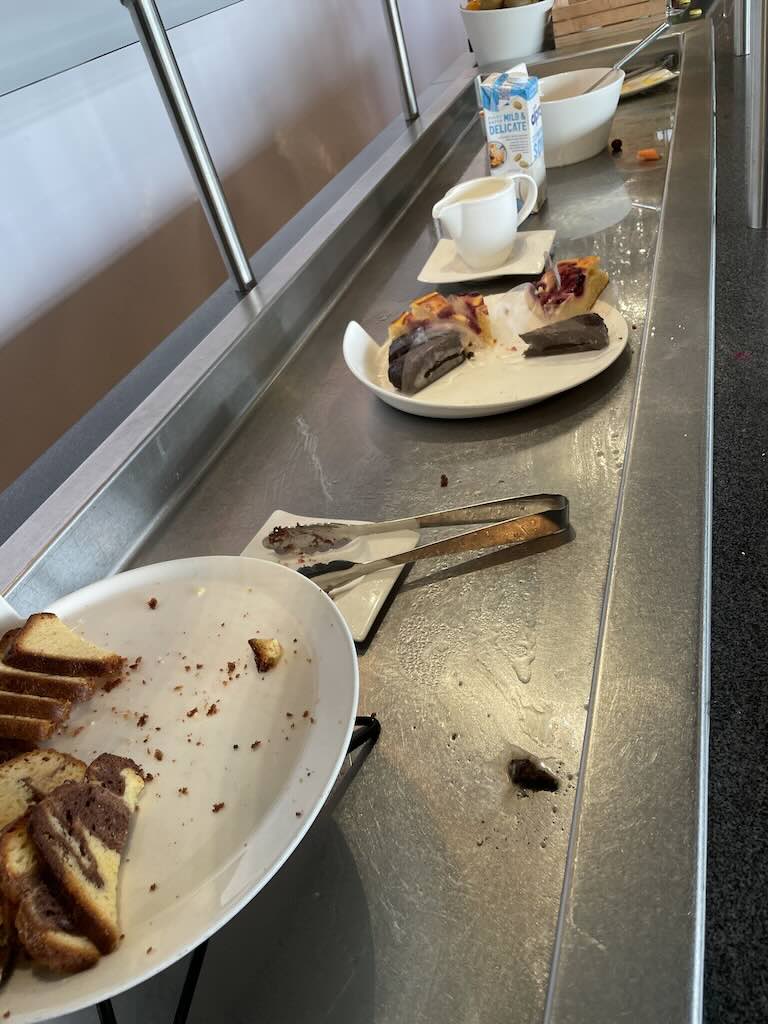
Luxair has now started grouping passengers for boarding. The boarding card includes a group (1-5) and boarding was first called for groups 1-3 (I was in group 3).
The ridiculous part was that we then spent around 20 minutes waiting in the terminal gate corridor. It was irritating to be standing near the jet bridge, and hear several “final calling” messages for our flight. No one told us if there was a problem, but it became evident that departure would be delayed.
Departure was for 16:35, but we finally left the gate at 17:19, 44 minutes late. But taxi time was another 12 minutes, so we actually took off at 17:31.
The reality is that the Luxembourg-Malaga leaves on average between 20 to 40 minutes late.
One really cool thing was that one passenger had his boarding card printed on his t-shirt.
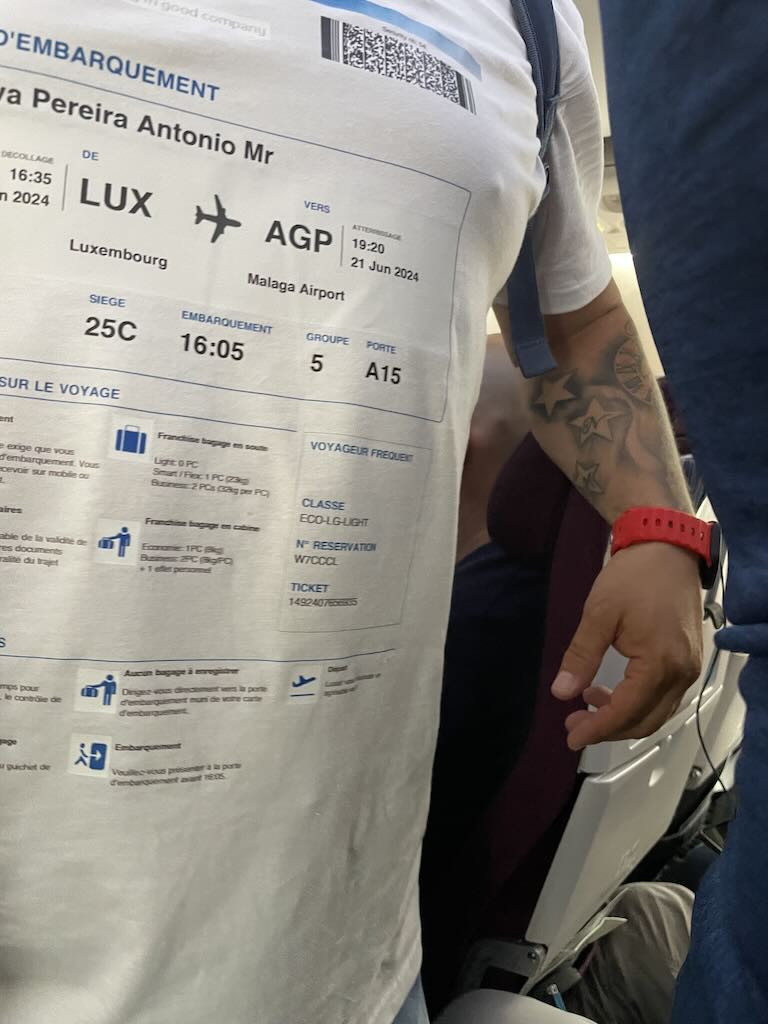

Not much to say about the flight itself. Above we can see the in-flight food. I had eaten some salmon and cheese in the lounge, so I picked at the main meal and drank some water and another coffee. The little salad was nice, but the chicken was a bit dry.
The aircraft was LX-LBK and the flight was scheduled to disembark in Malaga at 19:20, but actually landed at 19:53, arrived at its parking place at 19:58, but passengers were then bussed to the arrivals. By the time I got through arrivals (I only had carry-on), my pick-up had been waiting more than 1 hour. I had texted him that I would be late by 50 minutes.
The reality is that the Luxembourg-Malaga flight on average arrives between 40 to 60 minutes late.
What do we know about LX-LBK?

The aircraft was LX-LBK, and we know that on the 21 June it flew a return trip to Antalya (leaving Luxembourg at 06:15). It then flew the return trip to Malaga.
The route taken by Luxembourg-Malaga was quite different from the route taken for Malaga-Luxembourg. The flight Malaga-Luxembourg flew across Spain passing east of Madrid, and then cut diagonally across France to past Lyon on its eastern side. This flight Luxembourg-Malaga flew past Paris before flying more or less directly to Malaga (so across eastern France and central Spain). It’s interesting because this same aircraft then flew back to Luxembourg, again passing east of Lyon. So it looks as if the flight plans for Luxembourg-Malaga and Malaga-Luxembourg are quite different.
There was no logical reason for the long delay in boarding at Luxembourg, because the plane had landed from Antalya at 15:24, more than one hour before the scheduled departure time for Malaga. The same plane then flew a return trip to Luxembourg leaving Malaga at 21:31 and arriving in Luxembourg at 00:04 the next morning. The scheduled departure was 20:40 arriving in Luxembourg at 22:50. I can imagine for some passengers arriving after mid-night, 1 hour 24 minutes late might have caused some considerable inconvenience.
LX-LBK was originally EI-GFY with Air Italy, and it was only re-leased to Luxair on 5 September 2023, with a first flight 8 September 2023. The airframe (often just termed “metal” by frequent flyers) was originally delivered to Air Italy in May 2018, and immediately “withdrawn from use” and stored in Cairo International (CAI) until September 2019. It was then moved and stored again in Malpensa (MXP) until June 2020. Air Italy ceased operations in February 2020. Finally the airframe was then moved and again stored in Budapest (BUD) until late July 2023. From there it would have been moved to be redecorated internally and externally (seat covers, carpets, paint, logo, etc.).
So it looks as if the aircraft was six years old, but had never flown, except to be moved from one storage location to another.


